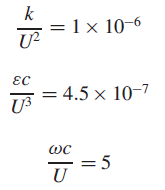No problem!
So how can I calculate or find the value of this so that I know I am within the 0.1-2 range?
No problem!
So how can I calculate or find the value of this so that I know I am within the 0.1-2 range?
Hi @dylan and good to see you back!
The SA 1 equation turbulence model is adapted for flows around an airfoil and as you know boussinesq approximations to not behave super accurate (whatever you define as accurate in this case), but a contracting section is a good example as the eddies loose their identity along the way. And standard k-epsilon is by definition not realizable (need a separate post to explain what that means) so one usually uses realizable k-epsilon but fully developed pipe flow for instance work pretty well with standard k-epsilon. k-omega SST does a pretty good job and there is no need for SA model, what do you think?
Best,
Jousef
Wow, Sydney, Florida and Germany all at the same time 


From Spalart and Rumsey, you have

Calculate k and omega using a length scale of your choice.
From this link Turbulence free-stream boundary conditions -- CFD-Wiki, the free CFD reference, you have

where,
![]() is the turbulent viscosity ratio;
is the turbulent viscosity ratio;
![]() is air density;
is air density;
![]() is dynamic molecular viscosity of air (not kinematic).
is dynamic molecular viscosity of air (not kinematic).
I exclusively use SpalartAllmaras, RealizableKE, and SST as RANS. In fact, I find SpalartAllmaras very useful for external aerodynamics with mild separation, such as a plane or a wing. I think @DaleKramer’s problem can be very well solved by SA, because I have done similar projects.
Aha, I finally see it, I can just back it out from known values.
And this means I really need to go to bed now … Thanks.
Dale
Hi @dylan,
I totally agree here but as SA is not implemented on our platform we have to work with another turbulence model.
Best,
Jousef
Just curious as to why you suggest calculating ut/u from the cfd_online.com formula rather than from the Spalart and Rumsey recommendation of 2e-7 * Re ?
There is a 20% difference in my case.
And by the way, I did have to change my reference length from a fuselage length of 5m to a value of 2m to stay in your suggested ut/u range of 0.1~2. My ut/u value is now 1.89 (EDIT actual value is now 1.6182, see edit 2 posts down).
Dale
Did you use the same length scale in Reynolds number?
Yes
EDIT: corrected the value for u (dynamic viscosity) which is equal to SimScale Kinematic Viscosity * Density
This makes ut/u smaller than the original post…
The 2e-7*Re is just an estimation. The actual nut calculated at inlet should return a nut/nu = 1.888 or much closer to 1.888. I don’t think a length scale of 2 or 3 will lead to much difference in Cd or Cl. It is safe to use what you have here.
Turbulent viscosity and eddy viscosity are the same thing. However, nut = mut/rho, where nut is commonly used in incompressible flow, and mut in compressible flow.
Hey guys.
Could you help with this? I think it might be related.
Hi @DaleKramer,
I hope you are doing well. I would like to know, is it okay if my ut/u ratio is equal to 0.1005 ? or Should I adjust any further ? My case is more or less similar, I am running a simulation of flying wing aircraft.
Kind regards
Mohammad Fozan
here what’s C? Is it the speed of the sound?
I need to find turbulent viscosity ratio for my SA model. Here my velocity is set 30 m/s.
please help me!
what did u consider as C in his equations?
If I use C as my Chord length, 0.15 m I get turbulent viscosity ratio as 0.0735. Is it fine for my model??
@vinulfernando c is the length scale (m) (in my case, I used length value which is slightly greater than the aircraft length), adjust c so that the ratio will be above or equal to 0.1.